
Conclusions
The 11th International Symposium on Environmental Pollution and its Impact on Life in the Mediterranean Region was jointly organised by the Mediterranean Scientific Association of Environmental Protection (MESAEP) and the Society of Ecotoxicology and Environmental Safety (SECOTOX) from October 6 to 10, 2001 in Limassol, Cyprus under the auspices of the Minister of Agriculture, Natural Resources and Environment and in collaboration with Universities and Research Centres from all over Europe and the Mediterranean Region. It was sponsored, among others, by the Municipality of Limassol, the Municipality of Nicosia, the Municipality of Paphos and the Cyprus Tourism Organisation.
Despite the extremely difficult political situation after the events in the USA the Symposium has welcomed more than 150 scientists from Europe, Middle East, Asia and North Africa that are engaged in research and development in the fields of environmental chemistry, technology and eco-toxicology. More than 130 papers were presented in form of plenary lectures and in poster sessions. The opening speech was held by the permanent secretary of the Ministry of Agriculture, Natural Resources and Environment in the presence of two Members of the parliament and the Mayor of the city of Limassol.
The Symposium has provided the opportunity for scientists and technicians from more than twenty countries to:
- exchange recent results related to the pollution of air, water and soil in the Mediterranean Region
- discuss current technological and legal measures to avoid or to reduce pollution and
- present suggestions and recommendations to the regulatory authorities on issues related to environmental quality and safety in the Mediterranean Region and other neighbouring countries.
The scientific programme included five sessions :Environmental Policy Atmospheric Chemistry and Climate Change Pathways and Effects of Chemicals in Terrestrial, Aquatic and Marine Ecosystems Environmental Control and Risk Assessment Waste Technologies The main results of the symposium can be summarised as follows:Environmental policy, environmental control, risk assessment
Environmental policy and education aspects were evaluated. In particular, issues related to the application of environmental policies in countries that are not belonging to the EU were thoroughly discussed and the need for the development and harmonisation of risk assessment methods for a successful risk management was highlighted.
Environmental education and training, it has been seen, as a challenging task and as the basis for a sustainable development in the countries of Southern Mediterranean. Moreover, as a possibility to get in touch with experienced scientists and to get informed on the application and the consequences of environmental policies.
Atmospheric chemistry
Photochemical pollution still remains a problem in Southern Europe. In particular, high ozone levels ( up to 400 µg/ m³ ) are recorded in many urban and rural areas. The possible origins of these high urban and rural ozone concentrations as well as their variation characteristics and some aspects regarding human exposure to ozone were discussed.
Individual studies were dealing with ambient air concentrations, sources and source apportionment for priority air pollutants in different city domains. However, still few studies on population exposure were presented, although human exposure has been clearly recognised as a very important tool for an integrated air quality management.
The results presented on the military use of depleted uranium and the herewith associated population exposure during the Balkan wars are highly interesting; they show that one can reasonably expect soldiers and population to develop certain tumours caused by depleted uranium.
Pathways and effects of chemicals
In this session emphasis was given on endocrine disruptors and the herewith associated biological effects measured as alterations on vitellogenin (VTG) synthesis on natural fish populations. Concentrations up to 30 µg/ l of nonyl phenol ethoxylate, 15µg/l of nonyl phenol and up to 35 µg/l of nonylphenoxy carboxylate were found in river waters in Spain. Similar concentrations were also detected in rivers and estuaries along the Mediterranean coast in Israel and their effects on various fish species were investigated.
Another issue which received high attention by the participants was the introduction of micro-system technology in environmental sensing, in particular, for water analysis. The system presented includes two ion selective sensors and an optofluidic micro-system which works as a micro-photometer. The whole device is used as a part of a groundwater monitoring network and allows frequent measurements at low cost.
Waste technologies
Industrial hazardous waste management practices applied at different Mediterranean countries were presented and discussed. A plenary lecture dealing with the environmental and health effects of biodiesel (mainly rape seed oil methylester) as alternative fuel found great interest. Compared to fossil diesel fuel biodiesel shows, as a main positive aspect, a significant reduction for soot and polycyclic aromatic hydrocarbons (PAH). Also the mutagenic potency of the exhaust particulate matter is much lower than that originating from fossil diesel fuel. However, the main problem from the use of biodiesel are the high amounts of NOx, aldehydes and other ozone precursors (alkenes) produced. Therefore, a higher ozone forming potential is expected.
Concluding remarks
Despite the particular political situation due to events in the USA and the highly unstable situation in the Eastern Mediterranean , the symposium in Limassol has demonstrated the great interest of the scientists in the Mediterranean Region for the problems related to environmental pollution. The symposium provided a platform for fruitful discussions on technical/scientific issues, on issues related to environmental education and training and to environmental law and information. Emphasis was given onto regulatory issues and assessments in close agreement with the practices used in the European Union. There is a tendency to harmonise and adopt methods and procedures in collaboration with EU member states and to participate to EU programmes.
